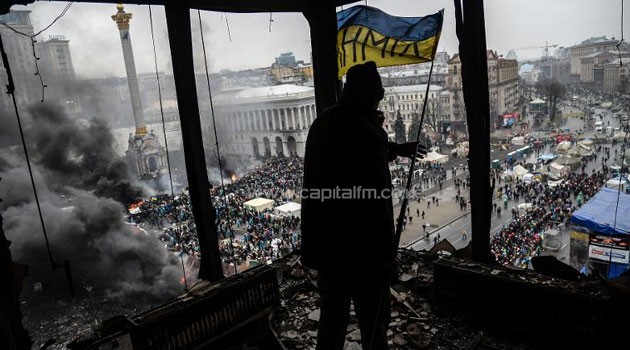
A demonstrator stands on a balcony overlooking Independence square during a face off against heavily-armed police on February 20, 2014 in Kiev
© AFP
KIEV, Feb 21 – More than 60 protesters were shot dead in the deadliest day of anti-government protests in Ukraine, opposition medics said as rival sides traded accusations of sniper attacks and EU ministers tried to broker an end to the crisis.
The deaths came as the European Union agreed to impose sanctions on Ukrainians with “blood on their hands”, though it left the door open to a political deal by naming no names.
The United States threatened to follow suit.
Ukraine’s embattled President Viktor Yanukovych appeared ready to concede to one of the protesters’ main demands by suggesting to visiting EU dignitaries that he may be ready to hold early elections.
German Chancellor Angela Merkel, meanwhile, spoke to Presidents Barack Obama of the United States and Vladimir Putin of Russia –- who have bickered openly over the crisis, which has pitted the ex-Soviet country’s future between Russia and the West — by telephone.
All three called for a halt to the bloodshed that has escalated since Tuesday.
Opposition medics said more than 60 protesters had been shot dead by police on Thursday alone. Kiev authorities, for their part, put the death toll from three days of violence at 75.
– ‘Shot in head or heart’ –
Bullet-riddled bodies were scattered on Thursday amid smouldering debris after masked protesters hurling Molotov cocktails forced gun-toting police from the capital’s Independence Square — the epicentre of the increasingly bloody revolt against Yanukovych’s pro-Russian rule.
Both sides accused each other of using snipers in a major escalation to a standoff that was sparked by Yanukovych’s rejection in November of an EU pact in favour of closer ties with Moscow.
But the White House said bluntly that it was “outraged by the images of Ukrainian security forces firing automatic weapons on their own people”.
US Secretary of State John Kerry stated the US “unequivocally” condemns the use of force against civilians, describing the deaths as “senseless”.
Volunteer medics, who made a makeshift morgue out of a popular hotel overlooking the square, also accused police of killing demonstrators with live rounds.
“They were shot in the head or in the heart by live bullets, not by rubber ones,” said first aid worker Natalia, who did not give a last name.
Ukraine’s interior ministry said only that it reserved the right to use live munitions “in self-defence”.
The ministry also accused “extremists” of seizing 67 of its troops at gunpoint and holding them hostage in one of the buildings near the war-scarred square.
– ‘No deal yet’ –
Events on the ground gave apparent impetus to political discussion, with some hope that Ukraine’s leaders were about to make concessions on the key issue of early elections.
“Among other things it was agreed with Yanukovych that there was a willingness to hold early elections this year – both presidential and parliamentary,” Polish Prime Minister Donald Tusk told reporters after a meeting with the Ukrainian leader in Kiev that included Warsaw’s top diplomat and the foreign ministers of Germany and France.
But Ukrainian opposition leader Vitali Klitschko quickly cautioned after his own subsequent meeting with the same EU troika that there was “no deal yet”.
Marcin Wojciechowski, spokesman for Polish Foreign Minister Radoslaw Sikorski, wrote on his Twitter account overnight Thursday that “negotiations with President Yanukovych are still underway”.
– EU sanctions –
The shocking scale of bloodshed in a strategic nation that serves as a brittle diplomatic bridge between Russia and the West prompted EU officials to slap travel bans against Ukrainians responsible for ordering the use of force.
Italian Foreign Minister Emma Bonino said an agreement was also reached at an emergency EU meeting in Brussels to impose asset freezes on those with “blood on their hands”.
The measures mark a U-turn for Brussels diplomats, who until Monday had resisted Ukrainian opposition demands for sanctions.
Vice President Joe Biden on Thursday warned Yanukovych that the United States was ready to impose sanctions on officials guilty of ordering troops to fire on protesters.
Washington has already put 20 top Ukrainian officials on a visa blacklist and threatened further sanctions, which could include asset freezes.
Ukraine’s former master Russia blasted the sanctions as “bullying”, and said President Putin was sending a representative to Kiev to act as a mediator in talks with the opposition.
Ukraine’s crisis has evolved into a broader anti-government movement that initially opposed Yanukovych’s spurning of an historic EU trade deal in favour of a $15 billion bailout from Kiev’s old masters in the Kremlin.
The unrest has also swept through the pro-Western west of the country, and parts of its more Russified east — exposing the deep historical fault lines between the two.
Yanukovych had appeared determined Wednesday to end the crisis by force after the security services announced plans to launch a sweeping “anti-terror” operation.
He also sacked the army’s top general — a powerful figure lauded by the opposition for refusing to back the use of force against protestors.
French foreign minister Laurent Fabius left Kiev Thursday for Beijing, according to journalists travelling with him.








































